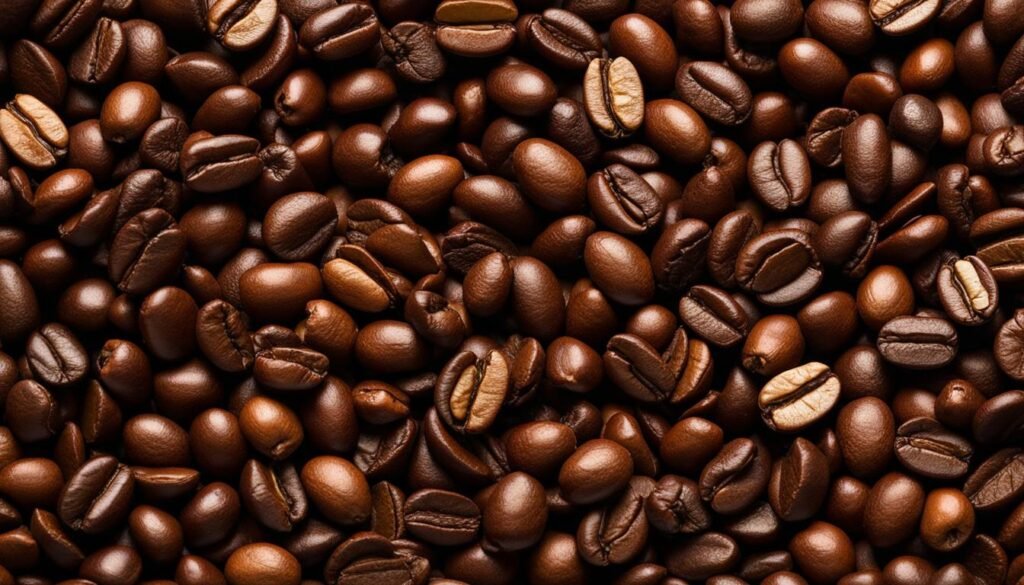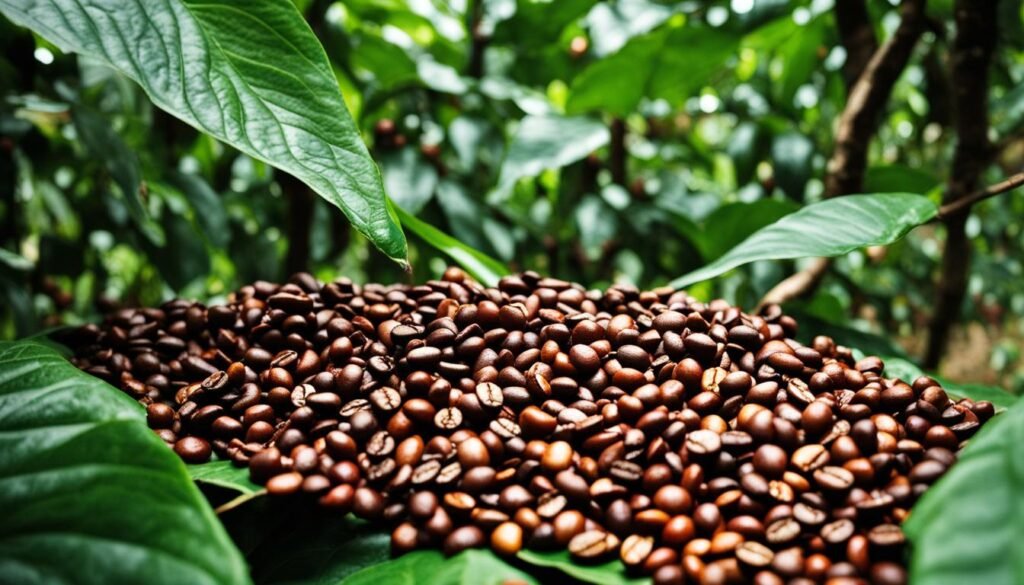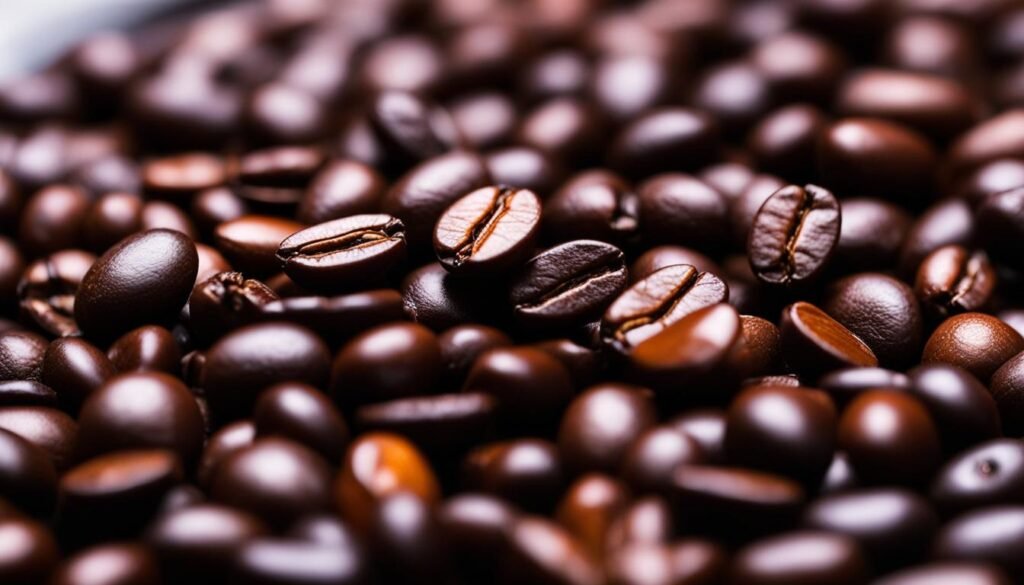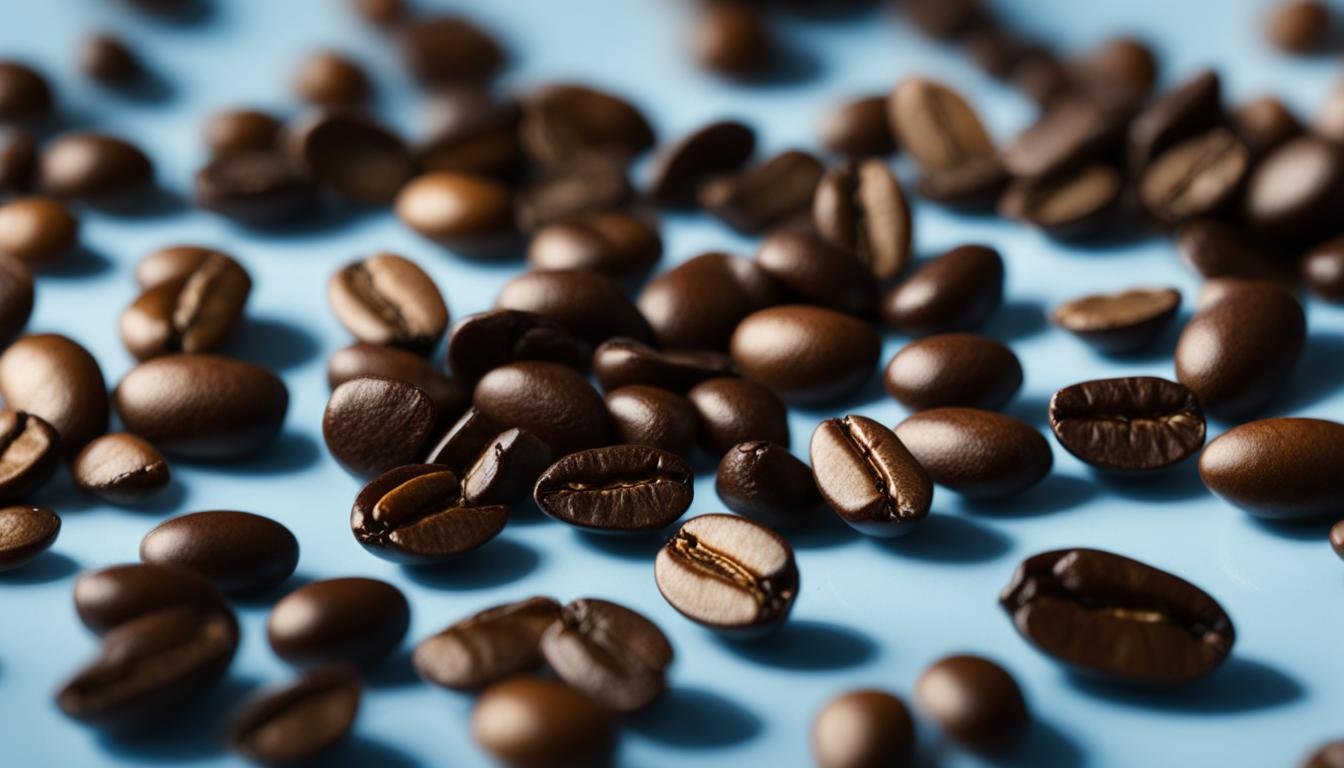Welcome to our article where we dive deep into the world of coffee and uncover the truth about caffeine in coffee beans. Coffee has long been a beloved beverage for many, but have you ever wondered if coffee beans actually contain caffeine? Join us as we explore the caffeine content in coffee beans and unravel the mysteries surrounding this popular drink.
Before we get started, let’s address the burning question: Do coffee beans contain caffeine? The answer is a resounding yes! Even though decaf coffee is often seen as caffeine-free, it still contains a small percentage of caffeine. Regular coffee beans, on the other hand, can have varying levels of caffeine, depending on factors such as roast, type of coffee bean, and brewing method.
Key Takeaways:
- Coffee beans do contain caffeine, even decaf coffee has a small percentage of caffeine.
- The caffeine content in coffee beans can vary based on factors such as roast, type of coffee bean, and brewing method.
- Decaf coffee typically contains about 1 to 2 percent of caffeine, with a cup of decaf coffee averaging up to 7mg of caffeine.
- Individual preferences and health conditions should be considered when choosing between regular and decaf coffee.
- Stay tuned as we delve deeper into the world of coffee, exploring topics such as decaf coffee production, caffeine content in different brands, and the health implications of consuming coffee.
How Decaf Coffee is Made and Its Caffeine Content
Decaf coffee is a popular alternative for those looking to enjoy the taste of coffee without the stimulating effects of caffeine. But how is decaf coffee made, and does it truly contain no caffeine? Let’s dive into the decaffeination process and explore the caffeine content in decaf coffee.
The Decaffeination Process
Decaf coffee is made from unroasted coffee beans, just like regular coffee. There are three primary methods used to remove caffeine from coffee beans: solvent-based, water-based, and carbon dioxide-based.
The solvent-based method involves soaking the dried green beans in a mixed solution of methylene chloride, ethyl acetate, and water to extract the caffeine. The Swiss water process uses osmosis to remove caffeine, and the carbon dioxide method uses carbon dioxide as a solvent to extract caffeine.
Caffeine Content in Decaf Coffee
Despite the decaffeination process, decaf coffee still contains a small amount of caffeine. On average, a cup of decaf coffee typically contains around 1 to 2 percent of caffeine, which translates to approximately 7mg of caffeine per cup.
The caffeine content in decaf coffee can vary depending on factors such as the type of coffee beans used and the brewing method. It’s important to note that decaf coffee is not completely caffeine-free, but the amount of caffeine is significantly reduced compared to regular coffee.
| Decaf Coffee Brand | Caffeine Content (per 8 ounces) |
|---|---|
| Starbucks Pike’s Place Roast | 20-30mg |
| Dunkin Donuts | 7-15mg |
| McDonald’s | 8-18mg |
Table: Caffeine Content in Decaf Coffee (Per 8 ounces)
| Type of Decaf Coffee | Caffeine Content |
|---|---|
| Brewed Coffee | 7-16.8mg |
| Instant Coffee | 3.1-7.5mg |
Caffeine Content in Different Decaf Coffee Brands
When it comes to decaf coffee, not all brands are created equal in terms of their caffeine content. The level of caffeine can vary significantly between different coffee chains and brands. If you’re looking for a truly caffeine-free option, it’s essential to pay attention to the specific decaf coffee brand you choose.
Here’s a breakdown of the caffeine content in popular decaf coffee brands:
| Decaf Coffee Brand | Caffeine Content per 8 ounces |
|---|---|
| Starbucks Pike’s Place Roast | 20 to 30mg |
| Dunkin Donuts | 7 to 15mg |
| McDonald’s | 8 to 18mg |
| Average Decaf Brewed Coffee | 7 to 16.8mg |
| Average Decaf Instant Coffee | 3.1 to 7.5mg |
As you can see, the caffeine content can vary quite a bit even within the same category. It’s worth noting that these numbers are approximate and can still depend on factors such as the brewing process and serving size.
So, if you’re looking to minimize your caffeine intake, it’s a good idea to check the caffeine content of the specific decaf coffee brand or chain you prefer. This can help you make an informed choice and ensure you’re getting the coffee experience you desire.
Is Decaf Coffee Healthy?
Decaf coffee is a popular choice for people who are sensitive to caffeine or have certain health conditions. While it is true that decaf coffee contains a small percentage of caffeine, it can still offer a number of health benefits.
For individuals who experience insomnia, palpitations, or anxiety after consuming regular coffee, switching to decaf can be a wise choice. Decaf coffee provides a similar taste and aroma to regular coffee, but with much lower levels of caffeine. This can help people enjoy their favorite coffee beverage without the unwanted side effects.
It’s important to note that decaf coffee still contains antioxidants, which are beneficial compounds that can protect against cell damage and provide various health benefits. These antioxidants can contribute to a healthy diet and may help reduce the risk of certain diseases.
| Decaf Coffee Health Benefits |
|---|
| Lower caffeine content |
| Suitable for caffeine-sensitive individuals |
| Contains antioxidants |
| Can be enjoyed without unwanted side effects |
However, it’s important to consider individual health conditions and consult with a healthcare professional for personalized advice. While decaf coffee can be a healthier alternative for many people, it may not be suitable for everyone. It’s always best to prioritize your own health and make choices that align with your specific needs and preferences.
Debunking Myths about Coffee’s Impact on Health

When it comes to coffee, there are many misconceptions about its impact on our health. In this section, we will address and debunk some of the common myths surrounding coffee and its effects.
The Myth of Coffee and Dehydration
One of the most prevalent myths is that coffee dehydrates the body. However, this is not entirely true. While caffeine has a mild diuretic effect, the water content in coffee compensates for this, preventing significant dehydration. In fact, studies have shown that moderate coffee consumption can contribute to daily fluid intake without causing dehydration.
The Effects of Caffeine
Caffeine, the primary active component in coffee, has both positive and negative effects on our health. On the positive side, caffeine can increase alertness and cognitive function, improve physical performance, and enhance mood. However, it can also disrupt sleep and lead to potential withdrawal symptoms if consumed in excessive amounts. The key is to moderate caffeine intake and be mindful of individual sensitivity to its effects.
| Myth | Fact |
|---|---|
| Coffee dehydrates the body. | Coffee’s water content compensates for the diuretic effect of caffeine, making it a hydrating beverage. |
| Coffee is bad for heart health. | Moderate coffee consumption is not linked to an increased risk of heart disease and may even have certain protective effects. |
| Coffee increases the risk of cancer. | Research does not show a significant association between coffee consumption and most types of cancer. |
Coffee and Heart Health, Coffee and Cancer
Two other common myths are that coffee is bad for heart health and increases the risk of cancer. However, scientific research does not support these claims. Moderate coffee consumption has not been found to significantly increase the risk of heart disease and may even have certain protective effects, such as reducing the risk of stroke and certain types of heart rhythm problems. Similarly, studies have not shown a significant association between coffee consumption and most types of cancer. As always, it’s essential to maintain a balanced and varied diet for overall health and well-being.
By debunking these myths about coffee and its impact on our health, we can make informed choices about our coffee consumption based on scientific evidence rather than misconceptions.
The Key Differences between Robusta and Arabica Coffee Beans

When it comes to coffee beans, two varieties dominate the market: Robusta and Arabica. Both have their own unique characteristics, ranging from taste and flavor to caffeine content and price. Understanding the differences between Robusta and Arabica coffee beans can help you make an informed choice and discover the perfect brew for your palate.
Taste and Flavor
Robusta coffee beans are known for their strong and bitter taste. They have a higher caffeine content, around 2.7%, which contributes to their bold flavor profile. On the other hand, Arabica beans offer a more delicate and nuanced flavor. They have a lower caffeine content, approximately 1.5%, resulting in a smoother and more aromatic taste.
Price and Quality
Arabica beans are generally considered higher in quality and are often associated with specialty coffees. They require specific growing conditions and are more susceptible to diseases, making them comparatively more expensive. Robusta beans, on the other hand, are more abundant and resilient to pests and diseases, making them a more cost-effective option.
Coffee Production
Arabica coffee beans are grown at higher altitudes, typically above 2,000 feet, in regions with a mild climate. They thrive in areas with well-defined seasons and require careful cultivation and harvesting. Robusta coffee beans, on the other hand, are primarily grown in lower altitude regions, such as Southeast Asia and Africa. They can withstand harsher conditions and are easier to cultivate, resulting in higher yields.
| Robusta Coffee Beans | Arabica Coffee Beans | |
|---|---|---|
| Caffeine Content | Approximately 2.7% | Approximately 1.5% |
| Taste | Strong and bitter | Delicate and nuanced |
| Price | Less expensive | More expensive |
| Quality | Lower quality (compared to Arabica) | Higher quality |
| Cultivation | Lower altitude regions | Higher altitude regions |
In summary, Robusta and Arabica coffee beans offer distinct characteristics that contribute to the diverse world of coffee. Whether you prefer the boldness of Robusta or the complexity of Arabica, there’s a perfect cup waiting for you. So go ahead, explore the flavors, and savor the journey of discovering your favorite coffee bean variety.
Growing, Processing, and Harvesting of Robusta Coffee

Robusta coffee is primarily grown in regions with lower altitudes, such as Southeast Asia and Africa. These areas provide the ideal environment for robusta coffee plants to thrive. They are more resilient to pests and diseases compared to arabica plants, making them a suitable choice for coffee farmers.
Altitude and environment play a crucial role in the cultivation of robusta coffee. These plants prefer lower altitudes ranging from sea level to around 2,000 feet. The warm and humid climate in these regions provides the necessary conditions for robusta coffee to grow and develop. The rich volcanic soils found in some of these areas also contribute to the robust flavor profile of the coffee beans.
When it comes to pest and disease management, robusta coffee plants have a natural advantage. They are less susceptible to common coffee pests like the coffee berry borer and diseases such as coffee leaf rust. This reduces the reliance on pesticides and allows for more sustainable farming practices.
Harvesting and Processing Methods
The harvesting and processing methods employed for robusta coffee can vary depending on the region and specific practices of the coffee farmers. In general, the harvesting process involves selectively picking the ripe coffee cherries from the robusta coffee trees. This labor-intensive process ensures only the highest quality cherries are selected for further processing.
Once harvested, the coffee cherries undergo a series of processing steps to extract the coffee beans. The two primary methods used for robusta coffee are the dry method and the wet method. The dry method involves drying the coffee cherries and allowing them to naturally release the coffee beans. The wet method, on the other hand, involves removing the outer pulp and fermenting the coffee beans before drying them.
After processing, the coffee beans are carefully sorted and graded based on their size, shape, and quality. This ensures that only the best beans are selected for roasting and brewing, delivering a rich and flavorful cup of robusta coffee.
Roasting and Brewing Robusta Coffee

When it comes to enjoying a cup of robusta coffee, the roasting techniques play a crucial role in bringing out the unique flavors and characteristics that make this coffee variety stand out. Roasting robusta beans requires careful attention to temperature and timing to achieve the desired flavor profile. One popular roasting technique for robusta coffee is the Italian tradition of dark roasting, which results in a rich and intense flavor with hints of chocolate and caramel.
To brew robusta coffee, there are various methods that can be used to highlight its distinct taste and aroma. One common brewing method is the espresso machine, which produces a concentrated, full-bodied coffee with a thick layer of crema on top. This brewing method perfectly captures the robust and bold qualities of robusta beans. Other brewing methods, such as drip brewing, French press, and cold brew, can also be used to enjoy the unique flavors of robusta coffee.
Comparison of Robusta Coffee Roasting Techniques:
| Roasting Technique | Flavor Profile | Aroma |
|---|---|---|
| Italian Dark Roast | Rich, intense, chocolatey, caramel | Strong and bold |
| Medium Roast | Moderate intensity, balanced, nutty | Subtle and inviting |
| Light Roast | Mild, mellow, fruity | Delicate and fragrant |
It’s worth noting that robusta coffee is often used in espresso blends to add depth and complexity to the flavor profile. The high caffeine content and strong taste of robusta beans make them an ideal addition to espresso shots. Additionally, robusta coffee is commonly used in the production of instant coffee, which offers convenience without compromising on flavor.
In summary, roasting and brewing robusta coffee requires expertise to unlock its full potential. From the dark roasting techniques to the various brewing methods, there are endless possibilities to explore and enjoy the bold flavors of robusta beans.
Conclusion
So, after diving into the world of coffee beans and caffeine, we can confirm that yes, coffee beans do contain caffeine. Even decaf coffee, which is often chosen for its lower caffeine content, is not completely caffeine-free. While regular coffee beans can contain anywhere from 70 to 140mg of caffeine per 8 ounces, decaf coffee still has about 1 to 2 percent of caffeine. The amount of caffeine in decaf coffee can vary depending on the type of coffee beans or the specific coffee drink.
It’s important to note that the caffeine content in decaf coffee brands can also differ. For example, Starbucks Pike’s Place Roast decaf coffee can contain 20 to 30mg of caffeine per 8 ounces, while Dunkin Donuts decaf coffee may have 7 to 15mg of caffeine per 8 ounces. McDonald’s decaf coffee falls within the range of 8 to 18mg of caffeine per 8 ounces. On average, a cup of brewed decaf coffee contains about 7 to 16.8mg of caffeine, while instant decaf coffee ranges from 3.1 to 7.5mg per 8 ounces.
So, whether you prefer regular or decaf coffee, it’s essential to consider your personal preferences and health conditions when making your choice. While decaf coffee can be a great option for those who are sensitive to caffeine or have certain health conditions, it still contains a small percentage of caffeine. So, next time you reach for that cup of coffee, remember that even though it may be decaf, a little bit of caffeine might still be in the mix!
FAQ
Do coffee beans contain caffeine?
Yes, coffee beans do contain caffeine, even decaf coffee is not 100% caffeine-free.
How much caffeine is in coffee beans?
Regular coffee beans contain about 70-140mg of caffeine per 8 ounces, while decaf coffee still contains about 1 to 2 percent of caffeine, with a cup of decaf coffee typically containing up to 7mg of caffeine.
How is decaf coffee made and what is its caffeine content?
Decaf coffee is made from unroasted coffee beans, just like regular coffee. There are three primary decaffeination processes: solvent-based, water-based, and carbon dioxide-based. Decaf coffee still contains about 1 to 2 percent of caffeine, with a cup of decaf coffee typically containing up to 7mg of caffeine.
What is the caffeine content in different decaf coffee brands?
The caffeine content in decaf coffee can vary between different coffee chains and brands. For example, Starbucks Pike’s Place Roast decaf coffee can contain 20 to 30mg of caffeine per 8 ounces, while Dunkin Donuts decaf coffee can contain 7 to 15mg of caffeine per 8 ounces. McDonald’s decaf coffee contains 8 to 18mg of caffeine per 8 ounces. On average, decaf brewed coffee contains 7 to 16.8mg of caffeine per 8 ounces, and decaf instant coffee contains 3.1 to 7.5mg of caffeine per 8 ounces.
Is decaf coffee healthy?
Decaf coffee can be a good alternative for people who are sensitive to caffeine or have certain health conditions. Decaf coffee still contains antioxidants and can offer similar health benefits as regular coffee. However, it is important to consider individual health conditions and consult with a healthcare professional for personalized advice.
Does coffee dehydrate the body?
Coffee does not significantly dehydrate the body, as its water content compensates for the mild diuretic effect of caffeine.
What are the effects of caffeine on health?
Caffeine has both positive and negative effects on health, including increased alertness and cognitive function, enhanced physical performance, mood improvement, sleep disruption, and potential withdrawal symptoms. Moderate coffee consumption is not linked to an increased risk of heart disease and may even have certain protective effects. Coffee consumption is also not significantly associated with an increased risk of most types of cancer.
What are the key differences between Robusta and Arabica coffee beans?
Robusta beans have a higher caffeine content (around 2.7%) compared to Arabica beans (1.5%). Arabica beans are known for their delicate and nuanced flavors, while Robusta has a stronger, more bitter taste. Arabica beans are generally considered higher in quality and fetch a higher price in the market. Robusta coffee production is more abundant and resilient to diseases.
How is Robusta coffee grown and processed?
Robusta coffee is primarily grown in lower altitude regions of Southeast Asia and Africa. Robusta plants prefer lower altitudes compared to Arabica plants. Robusta coffee plants are more resistant to pests and diseases, reducing the need for pesticides. Harvesting and processing methods for Robusta coffee include methods like wet hulling, which result in different flavor profiles in the final product.
How is Robusta coffee roasted and brewed?
Robusta coffee requires careful roasting at optimal temperatures to bring out its unique flavor profile. It can be brewed using various methods, such as drip brewing, French press, cold brew, and espresso. Robusta beans are commonly used in espresso blends to enhance the flavor and produce a thicker crema. Instant coffee production also often uses Robusta beans.

Leave a Reply